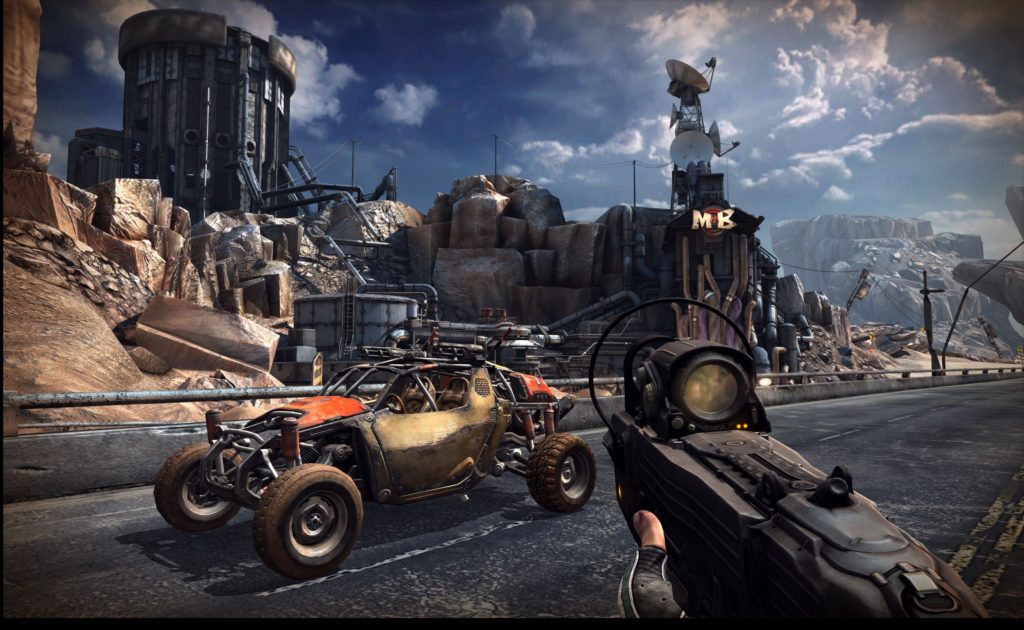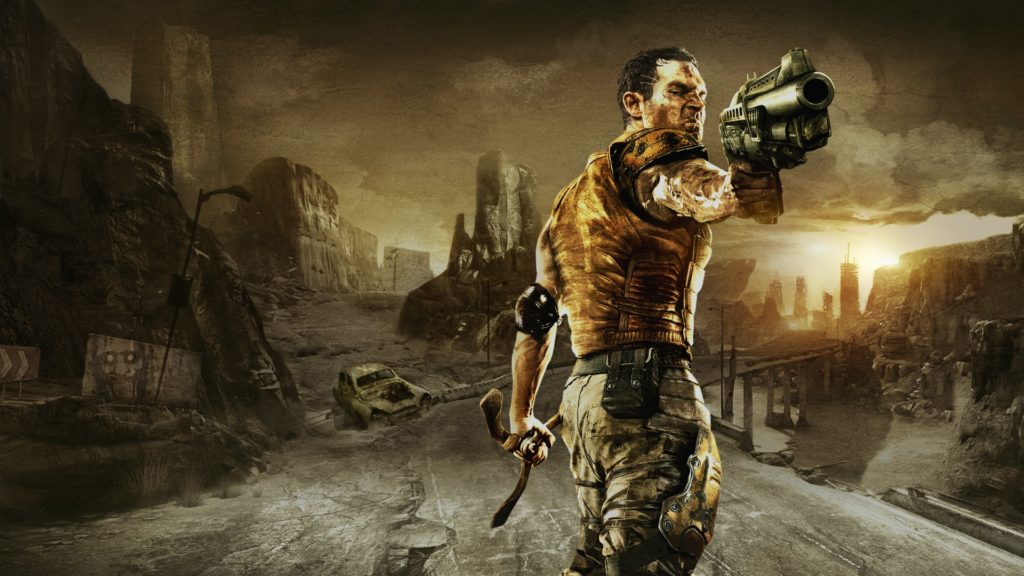id Software. The name of the company is synonymous with the entire first person shooter genre – it’s not something anyone else can claim, and for good reason: they invented it*. So when they release a new one, the world pays attention.
Their last new IP, Quake, was rather successful. It took the concepts crafted in id’s earlier work, Doom, into the third dimension – adding genuine depth to a genre that had, until then, been presented by way of smoke, mirrors, and more than a little audience good-will. It was a technical revolution – if not particularly groundbreaking in the story-telling department.
Which is a pretty good way to introduce Rage. Apophis, a real asteroid by the way, plows into the earth – you’re selected to survive and hide underground in an “Ark” so you can restore the status quo once the results of the asteroid’s impact settle down a bit. Something goes wrong and the world you revive in is not the one you were expecting.
That, unfortunately, is pretty much it. Yeah, the game expands on that foundation a little, but not so much as to fill so much as a single additional paragraph. Characters, what few there are, are two-dimensional (despite the awesome Carmackian technology that powers the game), and you won’t spend so much as a wry sniff caring about them.
Story? So what, right? It’s about the gameplay. That’s a laudable point of view – go you! However what’s here, while definitely fun and very well executed, doesn’t develop enough – for the most part – to be worth the price of entry alone.
There’s a bunch of gameplay types on offer, most of which are variants of shooting things or driving things – sometimes both at once, sometimes neither. You spend, for example, a long time driving a buggy around in the nuclear wasteland – sometimes racing, sometimes basically commuting. It’s all fun and very high tech but it feels like a demo of a full game, rather than a game itself.

There’s a bunch of different ways to interact with the world via the mechanic of the buggy, including a series of canned, lap-based races – with and without powerups (!). Think “Post Apocalyptic Mario Kart” and you’re as close as you need to be to get the general idea. It’s fun, sure, but it’s not a great fit for the serious “you survived the apocalypse – now survive the devolution of the species” premise that the game otherwise constructs.
You also spend a lot of time shooting and, true to form, this is where id’s latest game truly shines. The environments you explore are exquisitely detailed and the enemies, while occasionally a little dull in the smarts department, genuinely feel like a new and serious threat. They navigate the environment with a skill that suggests they really exist and are familiar with the place, and if you treat them like yet another modern battlefield soldier, you’ll get obliterated faster than you can say oh snap.
There’s a load of weapons and, in an implementation that’s sure to shock the Halo-and-later modern gamer, you can carry heaps of different ones at once – there’s no need to choose just two. The weapons are even customizable, with a variety of different ammo and upgrades available for each. Exploration and observation while on your seek-and-destroy missions will reward you well, with various bits and pieces to be found and traded as you attempt to improve your loadout and even the odds against the wasteland’s merry band of miscreants.

The loot, though, does fall somewhat short of the Blizzard-established norms. There’s more to it than simply finding a gun from a fallen foe, but quite a bit less than something like Borderlands. It feels like a trash-collecting housekeeper sim at times, as you collect a bunch of junk to sell so you can afford more ammo.
You can dig fairly deep into upgrading various bits of kit, though, which makes a nice change of pace from your standard action game without needing a pocket protector or spreadsheet to figure out RPG-like statistics. Whether that’s what you want from the game or not is something only you can decide – it’s certainly unique, anyway.
The technomalogical stuff is – for the most part – scarily impressive. For those of you who are unaware of the “megatexturing” technology that debuts with this game, it essentially means that everything you see as you roam the land has been uniquely painted by an artist. This is a stark contrast to every other 3D game you’ve ever played, in which textures (the bits painted by artists) are reused ad nauseum in order to ensure development (and rendering) is as efficient as possible.
Unfortunately, the implementation of this tech isn’t quite as seamless as you might otherwise have hoped (or thought, were you already familiar with the genius that is John Carmack, id’s technical wizard). Objects clearly pop in at the sides of the screen as you turn and often textures – particularly those in the distance – don’t load their high-resolution versions, at all. The result is, all too frequently, a bit of a mish-mash. It’s still impressive, but in that you have to add a bit of belief into the mix kind of way.
There’s also talk of some users having problems getting it to work full stop, particularly those with ATI cards. The review machine is rocking an Nvidia, with the latest drivers, and we had no issues that seemed in anyway related to the hardware or the platform (although it was clear that the focus of the title, by way of it’s interface, was the console owning masses – rather than being specifically targeted at the PC).
Ultimately, then, what you have here is a competently delivered title that’s mostly very polished and packed with variety (despite the occasional revisit to previously cleared-out levels). It feels a bit schizophrenic in terms of the types of things you do and the way the title is pieced together, yet the individual components are all a lot of fun.
It is, unfortunately, somewhat less than the sum of its parts. A good game and certainly worth experiencing, but not as cohesive or as impactful as what we were expecting the masters at id to deliver. Rather than raise the benchmark, as all of id’s previous games have done, it fails to meet the lofty standards already set by some of its contemporaries.